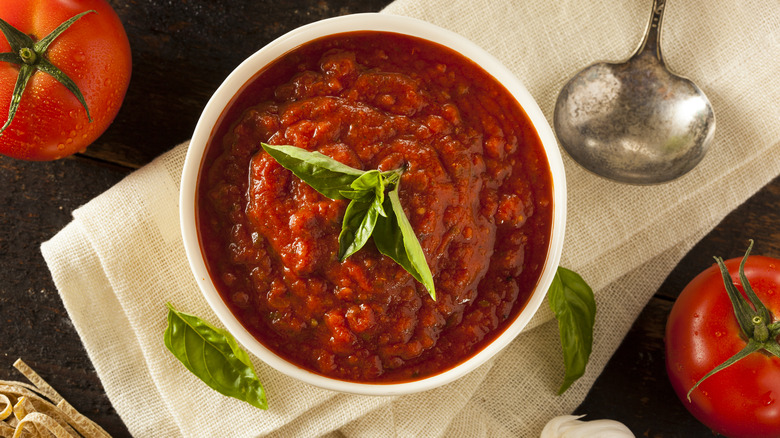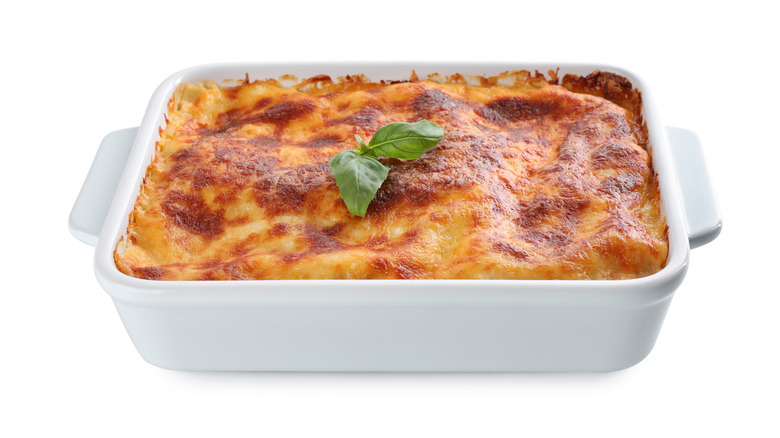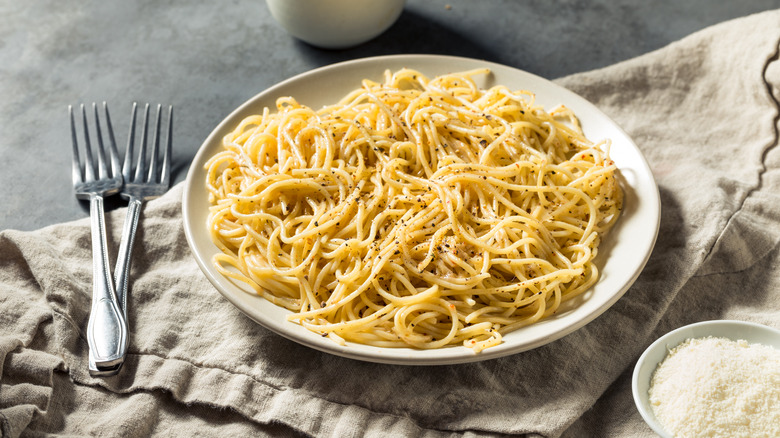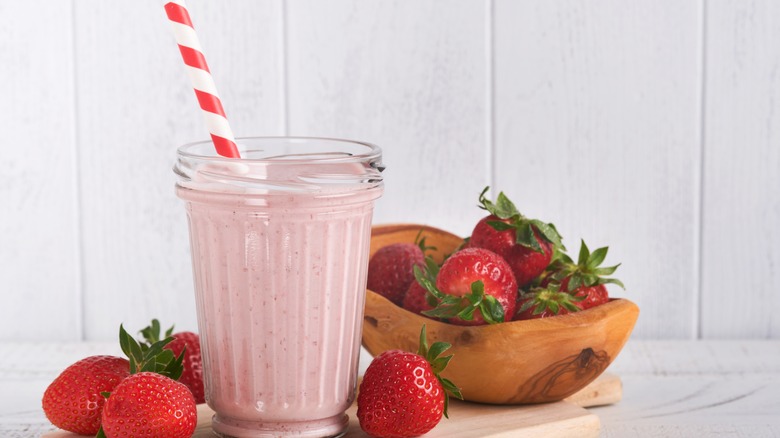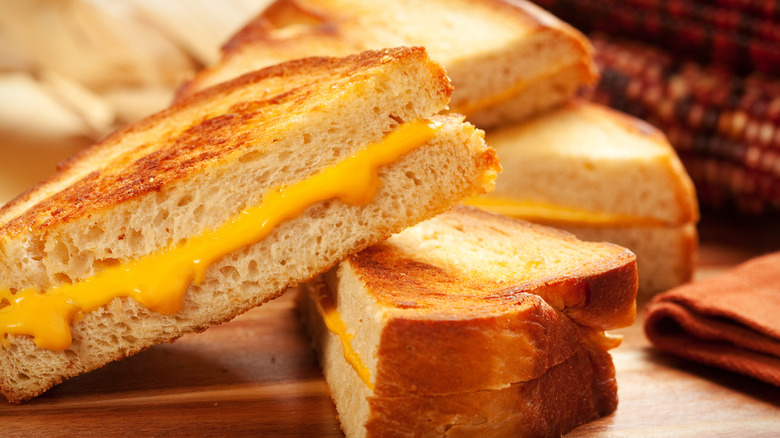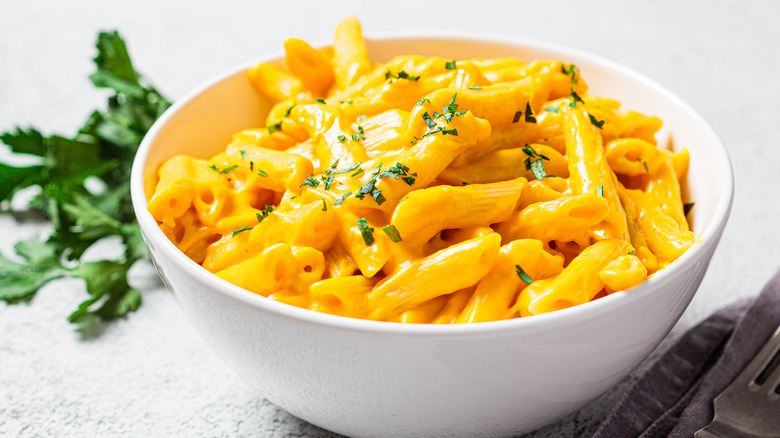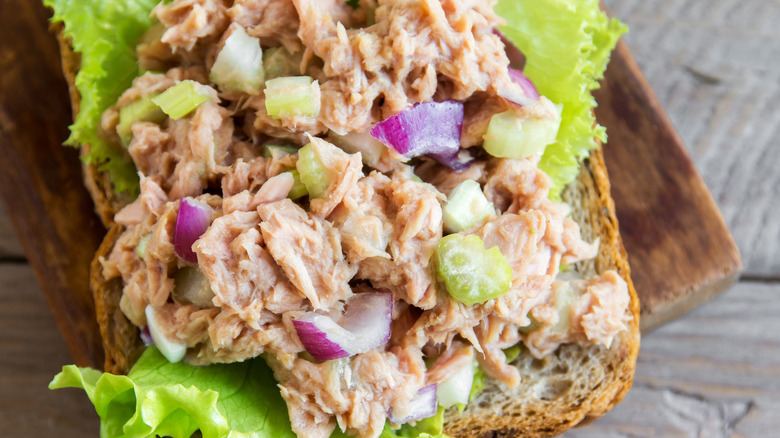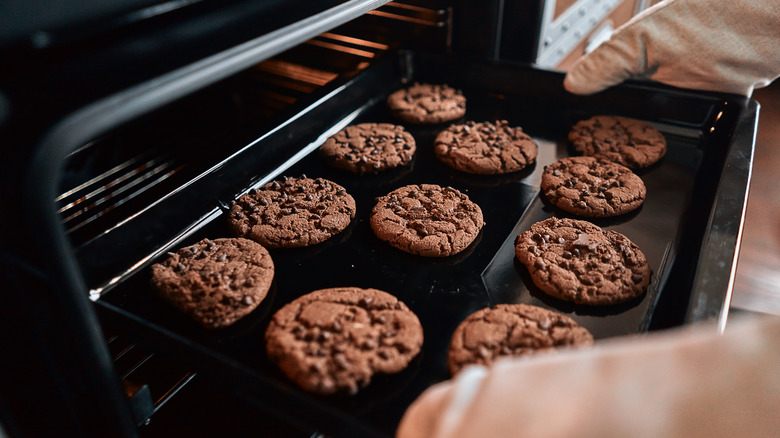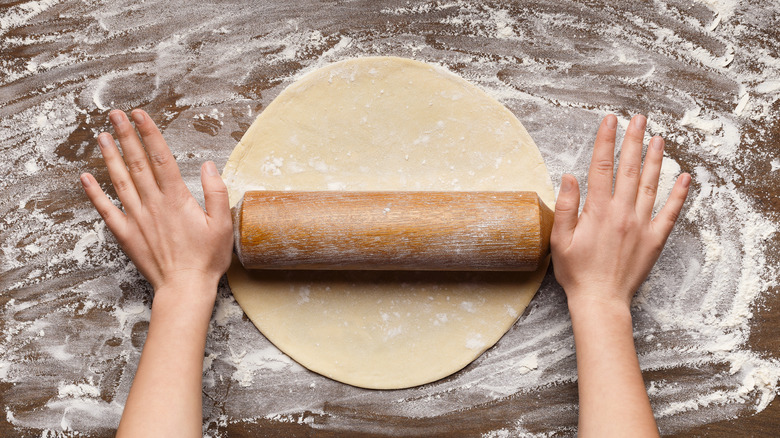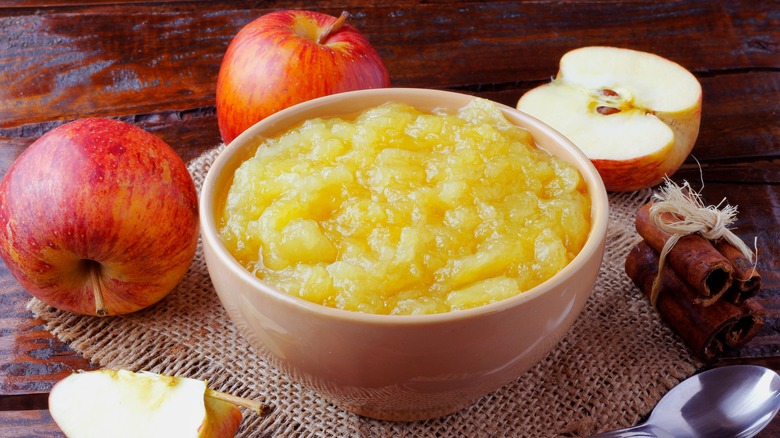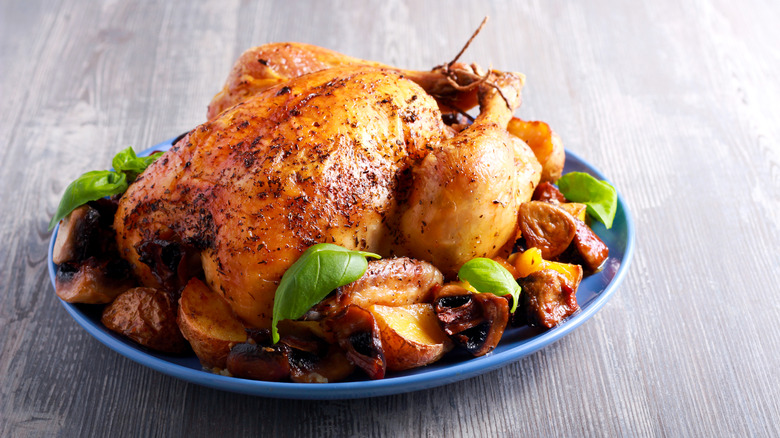12 Foods That Taste Better At Home Than From A Restaurant
There are many reasons we love to eat out. In some cases it's the ambiance, in others it's simply the convenience factor, plus it's always nice to enjoy a meal without having to put in any effort or the need to clean up once it's over. For the most part, however, what we like best about the dining out experience is a chance to eat foods we either can't make at home or else ones that simply taste better in a restaurant.
There are many types of foods that restaurants always seem to do better than at home – sushi comes to mind, as do simpler dishes such as waffles, pancakes, and even eggs. Steaks, too, are generally better (though much, much pricier) when cooked by professionals. Still, there is something to be said for home cooking, as it can offer nuances and personality you sometimes can't get at a restaurant. There are also certain dishes where a chef-created version is never going to match one made by even a reasonably skilled amateur. Here are our picks for the foods you should never order at a restaurant, and instead of these foods, order something else you can't get as good at home.
Spaghetti sauce
We'll start this one off with a disclaimer: If you grew up in the kind of household where spaghetti sauce typically came out of a jar, then you may well find restaurant sauce to be a superior product. If, however, you were lucky enough to grow up in a home with an Italian relative, then you know what tomato gravy and marinara really should taste like.
The problem with both restaurant and store-bought sauces may lie in the fact that someone once started a rumor that a pinch of sugar is needed to counteract the acidity of the tomatoes. This is absolutely not the case at all, especially when so many sauce makers go overboard and add so much sugar that the final product winds up being cloyingly sweet. Even worse is when there's an attempt to compensate for that sugary sauce by overdoing it on the garlic, as well. As Marcella Hazan, a chef who specialized in classical Italian cooking, once said of garlic, "It must remain a shadowy background presence. It cannot take over the show," quoted in Garlic: An Edible Biography. Sadly, most Italian restaurants in the United States don't seem to have grasped this principle. In order to avoid spaghetti sauce that's neither too sweet nor garlicky enough to kill off any vampires within a 10-mile radius, you're better off making it at home.
Lasagna
Homemade lasagna, too, is better than the restaurant version for several reasons. The first of these is that lasagna is typically made with marinara sauce or bolognese sauce, and, as we previously mentioned, the restaurant-made sauce is never going to be as good as homemade tomato sauce. There's also another issue with lasagna, however, and that has to do with the size of the dish.
Lasagna is typically baked in a large pan to make for a family-sized meal. This is fine if you are at home and even better if you happen to have a large family. When you order a piece of lasagna at a restaurant, however, unless you luck out and get the very first piece that comes out of the pan, there's a chance that your lasagna may have been sitting around for a while. If this is the case, it's likely that the noodles and cheesy topping may have dried out a bit. Speaking of cheese, that's yet a third issue we have with some restaurant lasagnas — oftentimes the cooks tend to go way too heavy on the mozzarella. With a good lasagna, you'll be tasting each layer, but in an overly-cheesed one, the flavors of the ricotta and sauce may get lost in the mix.
Cacio e pepe
Cacio e pepe, which has become quite trendy of late, is an Italian dish whose name translates to "cheese and pepper." While this recipe name doesn't tell quite the whole story, it does name two of the three most important ingredients, There's only one more element that's truly vital to the dish, that being the pasta. Once you put together the cheese (pecorino romano, please!) with spaghetti or bucatini and add a few grinds of pepper, you really should leave well enough alone, but this is something that many restaurants fail to do.
It's quite likely that higher-end restaurants where prices run well into double digits for side dishes may feel compelled to offer something extra for the price. Still, adding cream to cacio e pepe amounts to gilding the lily since this dish is meant to stay simple. We're not going to kick a cream-sauced cacio e pepe off the plate if it accompanies our entrée, but we far prefer our own simpler homemade version. In fact, cacio e pepe hits the home-cooking trifecta, as it's easy to make, tastes great, and is also pretty darn cheap. This basic recipe is one to add to your repertoire for those nights when you want something that can be thrown together in minutes from ingredients you may already have on hand but still feels a little bit fancy, thanks to the Italian name.
Smoothies
In 2016, a group of European researchers was looking into what factors determine whether people prefer homemade foods or prepared ones and they came up with a pretty interesting conclusion. According to a study they performed, reported in Market Watch, it seems that people generally prefer to make healthier foods at home, while they'd rather outsource the ones they perceive as being more indulgent. One food item that was used in the survey was a simple smoothie, with most of the participants giving higher ratings to the ones they made themselves.
According to science, the reason for this preference may be because you feel proud of seeing all of the healthy ingredients that go into your smoothie. Another factor at play may be that smoothies are highly customizable — you can choose dairy, plant-based milk products, or no dairy at all. Banana or no banana? Thick or thin? Green or pink? If you make smoothies in your own blender, you can add in all kinds of superfood boosters without paying an enormous upcharge, as well. The very best part of DIY smoothies, though, is that you can also leave out all the stuff you don't like. (Thanks, but we'll pass on the kale, as we'd prefer to save it for salads.)
Cereal
Back in the 2010s, we saw the birth of a new phenomenon: cereal cafes. They are restaurants that offer boxed cereals along with an array of milk (chocolate, soy, hemp, etcetera), and mix-ins ranging from seeds, nuts, and fresh fruits to candies and cookies. Sure, it was a cute concept, and for a while, cereal cafes were such a fun novelty. Honestly, though, we really don't think that a cereal cafe is a place we'd want to visit more than once.
There are pretty much two reasons to eat breakfast cereals. If you usually eat cereal in the morning, chances are this is because you appreciate the fact that it's quick and convenient and can be shoveled into your mouth in a matter of minutes before you sprint out the door. If you're more of a cereal-for-dinner person, it's probably because this is the kind of comfort food that's best enjoyed while kicking back in front of the T.V. wearing your pajamas. Plus, everyone knows cereal tastes extra-delicious if it's eaten out of that Teenage Mutant Ninja Turtles bowl you got free in a box of Cookie Crisp back in the '90s. As restaurants tend to frown upon such extreme haste, guests wearing pajamas, and guests bringing their own tableware, we feel that cereal cafes are a fad that belongs back in the previous decade.
Grilled cheese
Grilled cheese is another once-basic food that turned into a 2010s phenomenon. In fact, restaurants specializing in this meant-to-be-simple sandwich started offering gourmet versions such as Havarti with braised leeks or chèvre with apricot-jalapeño relish. By 2011, we were seeing grilled cheese cookbooks such as Laura Werlin's "Grilled Cheese, Please!" Over a decade has passed since gourmet grilled cheese became a thing, but this fad is proving to be surprisingly long-lasting for reasons that elude us.
Grilled cheese, like cereal, is one of those classic comfort foods where basic really is better. A recent survey found that the majority of grilled cheese sandwich makers preferred a simple slice of American to fancier ones, but there's no need to get a restaurant to cook this for you. After all, the best part of eating a grilled cheese sandwich may well be the nostalgia factor that comes with making something that you probably learned to prepare back when you were still in elementary school. Sure, you can tweak your grilled cheese technique if you wish, or even add your own embellishments like pepperoni, bacon, or even fig jam. But at the end of the day, the perfect grilled cheese sandwich is whatever you want it to be, and that's something you're only going to get if you make it yourself.
Macaroni and cheese
Macaroni and cheese is yet another food that's gotten a glow-up in recent years. Macaroni and cheese restaurants have opened up nationwide, and even eateries not specifically specializing in this dish have been rushing to put a special spin on it with add-ins such as barbecue sauce, apples, or pineapple. All are interesting tweaks, to be sure, and some of them are probably worth a try. Still, none of these amped-up cheesy noodle creations are ever going to take the place of the classic version.
As a matter of fact, for many of us, the whole idea of mac and cheese as comfort food is based on the version we ate as kids — yep, the kind that comes straight out of the box. That's not the sort of thing that any of us would want to admit to our foodie friends, perhaps, but it's the perfect dish for solo dining when no one's around to pass judgment. The heart wants what it wants, and so does the stomach. Still, this is a secret best kept to ourselves and our own internal organs, as it's one that likely no restaurant chef would understand.
Tuna salad
We know we've taken issue with a lot of trendy comfort foods getting too big for their britches — to the point where they're no longer quite so comforting. Tuna salad, however, has the opposite problem. It seems as if sandwich shops and diners (the only two places likely to have it on the menu) see tuna fish as an option, the kind of thing that's only likely to sell to people on strict diets or observing religious restrictions. This means that most restaurant tuna salad tends to be bland and boring, and the only way to redeem them is to turn them into a tuna melt with a generous amount of cheese.
Homemade tuna salad, however, can actually be pretty exciting stuff. Tuna comes in all kinds of flavors these days, plus you can doctor up your tuna salad with all manner of add-ins like pickles, onions, jalapeños, lemon juice, vinegar, or even a sprinkling of fish sauce for an extra hit of umami. You can also add in a handful of uncooked oats as a budget stretcher that doubles as a fiber boost (this trick works with ground beef, as well). For a vegan, tasty mayonnaise replacement, you might even like to try using mashed avocado. Sure, tuna and guac sound like an odd mashup, but it's one that actually works surprisingly well.
Cookies
As anyone who's ever attended a holiday cookie exchange or school bake sale can attest, there really is no substitute for home-baked cookies. They just have that certain je ne sais quoi that sets them apart, not only from store-bought ones but even from cookies produced by high-end bakeries. Still, we can't just leave it at that, so let's dive a little deeper into just what makes homemade cookies so good.
When you compare homemade cookies to store-bought ones or even ones from a grocery store bakery, it's all about the butter. Mashed taste-tested several types of cookies from Kroger and found that while they were not too bad overall, not one was made with butter, and the lack of this key ingredient definitely impacted the flavor. There's a different problem, however, with cookies from fancier bakeries. Those establishments are most likely using real butter and other high-quality ingredients, but where they err is by trying too hard. While jumbo-sized, over-embellished bakery creations are impressively symmetrical and undeniably pretty, somehow these eye-catching cookies never seem to have as much flavor as the smaller, slightly raggedy ones that come out of your own oven. What's more, when you bake your own cookies, you can not only scarf down a few while they're still hot and gooey, but you can even nibble on the dough if you're not afraid of a little raw egg.
Pies
Pies are big business these days, with many pie bakeries shipping products nationwide. While these pies tend to be pretty pricey, with some running upwards of $50 (not even including shipping and handling), people still seem to be buying them in such numbers that many bakeries warn of selling out well in advance of pie-heavy holidays like Thanksgiving. Okay, we get it, pies are pretty fiddly to make, so it may well be tempting to outsource the work if you can afford to do so. The problem, though, is that even the very best bakery pies just don't seem to live up to the homemade kind.
There are a few reasons for this, though we think the main one is that in order for pie crust to come out perfectly flaky and full of flavor, you need what's sometimes described as a "light hand." Oftentimes at large-scale bakeries, this magic touch is somehow lost when you're turning out pie after pie to stock the bakery shelves. Bakery pies, too, are meant to please the masses, which means that the fillings may be too sweet, too bland, or just not quite as tasty as they could be. When you make your own pies, you can tweak them to your own taste by dialing back on the sugar, adding a squeeze of lemon juice, using shortening or butter or a mix of the two in the crust, or even sprinkling some cinnamon or nutmeg into the dough.
Applesauce
Applesauce is the kind of thing that's typically served by restaurants claiming to offer home-style cooking, but, ironically, the stuff often seems to come straight out of a jar. Jarred applesauce is a food that seems tailor-made to please the plate of the average three-year-old: It tastes very little like apples and more like a bland, sweet mush. Homemade applesauce, however, is something completely different and, needless to say, is a far superior product.
Making your own applesauce is as easy as... no, it's far, far easier than pie. All you need to do is chop and core the apples, as even peeling them is optional. Simmer them in water, mash them to your desired degree of chunkiness, and sweeten them to your own personal preference by using either brown sugar, white sugar, or a sugar alternative such as honey or agave. In fact, you can even opt for no sweetener at all, as apples on their own are perfectly palatable. You may wish to add some lemon juice to your sauce for a little tang or sprinkle in some cinnamon and nutmeg for more of an apple pie-type taste. You can choose your own apples, as well, perhaps mixing and matching the sweet with the tart. Making your own applesauce also means you'll likely have leftovers that can be put to good use in baking or sorbets or even repurposed as DIY fruit leather.
Roast chicken/turkey
Roast chicken from a restaurant is generally not worth bothering with, and this goes for turkey, as well. The reason is, these birds are generally roasted whole, but in most cases, unless you're ordering a family-sized meal, you're only getting served a portion. The question you may be asking yourself is which part did you get? Did you get the first cut or the one that's been sitting in the kitchen for a while? Not that we're suggesting it's a health hazard, since restaurants are generally pretty careful about that sort of thing, but still, your roast bird might have had time to dry out a bit under a heat lamp, so it may not be as fresh as it could be.
Both roast birds, however, are pretty darn easy to prepare at home. Even better, they often tend to be quite budget-friendly, as well. There are also numerous different recipes for roast chicken and turkey. With the former, you can go with a tried-and-true classic as endorsed by Julia Child, or you can spice things up with something like this coconut milk and lemongrass Indonesian roast chicken. With the latter, you have options galore ranging from a turkey wet-brined in maple syrup and soy sauce to a Portuguese-style roast marinated in paprika and beer.

